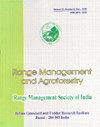Evaluation of machine learning models for prediction of daily reference evapotranspiration in semi-arid India
IF 0.8
4区 农林科学
Q3 AGRONOMY
引用次数: 0
Abstract
Reference evapotranspiration (ET ) is controlled by climatic factors; hence, its estimation provides an idea 0 about the atmospheric demand of water. Machine learning techniques like elastic net (ELNET), K-nearest neighbours (KNN), multivariate adaptive regression splines (MARS), partial least squares regression (PSLR), random forest (RF), support vector regression (SVR), XGBoost and cubist were employed to predict daily reference evapotranspiration based on daily weather parameters of twenty years. Penman-Monteith method was used as the reference method for ET estimation. All models performed well during calibration showing 0 higher coefficient of determination (R2) which ranged from 0.97 (for PLSR) to 1 (for cubist models). Mean absolute error during calibration ranges from 0.027 mm d-1 for cubist to 0.607 mm d-1 for ELNET. Cubist model (R2 = 1, MAE = 0.017 mm d-1, RMSE = 0.027 mm d-1) outperformed other models during the calibration. During validation, the coefficient of determination (R2) for the machine learning models varied from 0.819 to 1, RMSE varied from 0.06 to 0.60 mm d-1 and MAE varied from 0.031 to 0.38 mm d-1. Based on statistical parameters, best performance was observed for cubist model (R2 = 1, RMSE = 0.06 mm d-1, MAE = 0.031 mm d-1) among the studied machine learning models for the prediction of reference evapotranspiration. Hence, the cubist model may be used to estimate daily reference evapotranspiration for the studied region.半干旱印度每日参考蒸散量预测的机器学习模型评估
参考蒸散发(ET)受气候因子控制;因此,它的估算提供了一个关于大气对水需求的概念。采用弹性网(ELNET)、k近邻(KNN)、多元自适应样条回归(MARS)、偏最小二乘回归(PSLR)、随机森林(RF)、支持向量回归(SVR)、XGBoost和cubist等机器学习技术,基于20年逐日天气参数预测参考蒸散量。Penman-Monteith法作为ET估算的参考方法。所有模型在校准期间表现良好,显示出0较高的决定系数(R2),其范围从0.97 (PLSR)到1(立体派模型)。校准期间的平均绝对误差范围从cubist的0.027 mm d-1到ELNET的0.607 mm d-1。立体模型(R2 = 1, MAE = 0.017 mm d-1, RMSE = 0.027 mm d-1)的校正效果优于其他模型。在验证过程中,机器学习模型的决定系数(R2)范围为0.819至1,RMSE范围为0.06至0.60 mm d-1, MAE范围为0.031至0.38 mm d-1。基于统计参数,立体模型(R2 = 1, RMSE = 0.06 mm d-1, MAE = 0.031 mm d-1)在预测参考蒸散的机器学习模型中表现最好。因此,立体模型可用于估算研究区域的日参考蒸散量。
本文章由计算机程序翻译,如有差异,请以英文原文为准。
求助全文
约1分钟内获得全文
求助全文
来源期刊

Range Management and Agroforestry
AGRONOMY-
CiteScore
1.50
自引率
62.50%
发文量
25
审稿时长
>12 weeks
期刊介绍:
The Society has been established with the following objectives:
1. To advance the cause of research activity in all aspects of rangelands and to encourage and promote the studies on rangeland, wasteland ecosystems and agroforestry.
2. To provide facilities for seminars and conferences to rangeland researchers, development workers and farmers and to encourage close cooperation with organizations having related aims and interests.
3. To disseminate the knowledge of scientific agriculture and technology for forage and rangeland production, improvement and management.
 求助内容:
求助内容: 应助结果提醒方式:
应助结果提醒方式:


